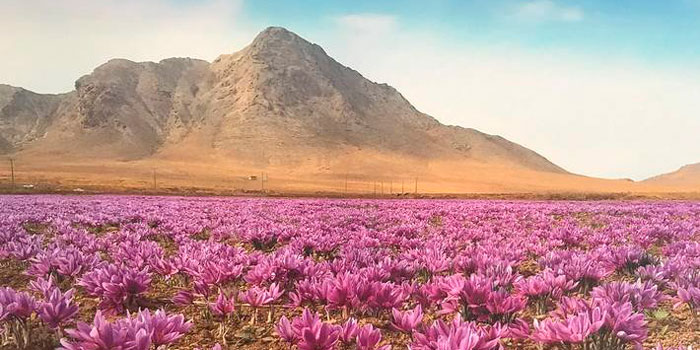Qanat-based Saffron Farming System in Gonabad, Iran
GIAHS since 2018

Detailed Information
Food and livelihood security
Iran is the largest producer of Saffron in the world and has over 90% Saffron production worldwide. Khorasan Razavi province and Gonabad region are part of central Iranian plateau with arid and semiarid climate. Persistence of such climate resulted in water scarcity and poses challenges toward improved food security and livelihood of residents of these areas. However, proper use of water resources supplied from Qanat System and promotion of products with high rate of added value, especially Saffron, created unique opportunity for farmers and residents of the region to improve their livelihood.
Saffron is an exceptional plant in the region that is resistant to drought, and is considered a valuable and worthwhile product, due to the shortage of water. This encourages farmers to develop Saffron cultivation, as well as a stable and profitable job for about 400,000 people in the region. Saffron cultivation accounts for 35 percent of the revenue from the total agricultural income of the city.
Agrobiodiversity
In the county of Gonabad, there is high agricultural diversity in the mountainous areas; for example, the diversification of crops in the historical and important village of Tak Meidan in the rural district of Kakhak of Gonabad. Plant and animal species in the historical and important village of Tak Meidan in the Kakhak rural district of Gonabad are also much diversified. Due to its high ecological diversity, the village accommodates a large number of mammals and wild birds at its optimum level and hosts them efficiently.
Local and traditional knowledge systems
Qanat system is a reliable source of water and supports preservation of biodiversity and productivity. They represent a unique and integrated system whereby sustainable management of land, water, and agricultural biodiversity is attained through a wide use of the indigenous knowledge and wisdom. Considering that Gonabad region has no perennial stream and surface waters of the area are limited to seasonal streams, underground waters are main source of water for agricultural and drinking purposes. Genius of Iranian ancestors in designing Qanats protected these unique structures from hostile agents and environment for millennia and supplied water for over 2500 years. Even though several thousand years have passed since the innovation of Qanat technology, this method of water transfer and use is still common in some villages and residential areas, agriculture and livestock, and is even the main pillar of cultivation in dry areas.
By relying on knowledge of planting, caring and harvesting, technology and local and indigenous experiences acquired from their ancestors and using indigenous knowledge of the region, peasants have tried to improve Saffron cultivation and plantation.
Cultures, value systems and social organizations
Saffron has a high symbolic value in Iran. Its blossoms in the spring are a symbol of beauty and youth. The freshness and beauty of Saffron blossoms provide the city of Gonabad to become as a haven in the heart of the Binalud desert plains and as a symbol of beauty and happiness, freshness and liveliness. Saffron is a fragrant and natural flavor and color, and delivers a special flavor to foods. It is warm in humor, and is commonly used in Iranian cuisine as a joyful material. It is used extensively in foods (especially with rice), sweets, cakes, ice creams, drinks and so on.
For a long time, it was used as a cure for cough, cold, stomach illness, insomnia, uterine bleeding and heart disease and bloating. Saffron has always a special place among our Iranians, and its taste and aroma are always reminded of Persian original dishes. Saffron is a plant that has a medicinal effect in many cases and has a positive effect on the treatment of certain diseases.
This place that reflects the role of women beyond formal culture, as the role of women becomes more pronounced at the time of cultivation. Women are at all stages apart from their usual activities working along with their families; perhaps, because Saffron is more than a commercial commodity and has come into the family structure, and they usually manage and coordinate family in these days. In all stages of cultivation of Saffron in Gonabad.
Landscapes and seascapes features
Saffron farms of the area are mostly built on sloped plane in form of small terraces which gave the area astonishing view. Area of Saffron farmlands of Gonabad’s neighborhood exceeds 2,000 ha. These areas have highest quality, best access and most irrigation. During the harvest season, aerial view of the region stunning.
Flower of Saffron, in its natural beauty and violet, red and yellow colors, gives the city an astonishing look. Natural beauty of the region and unique architecture of residence of people which his result of beautiful crops and Saffron flowers are among aspects of the area which promote tourism and eco tourism. Gonabad hosts considerable areas of farmlands in surroundings of residential areas. Additionally, at the edge of Saffron farms, fruit trees such as almonds, berries and etc. are planted which create unique landscape accessible through a short trip from the city. On the other hand, Saffron flower parts which are disposed as waste, create purple piles of flower parts in corners of alleys and streets of the city.

